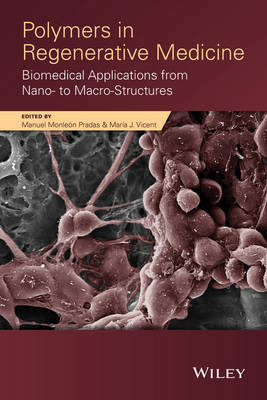
Polymers in Regenerative Medicine
John Wiley & Sons Inc (Verlag)
978-0-470-59638-8 (ISBN)
Biomedical applications of Polymers from Scaffolds to Nanostructures
The ability of polymers to span wide ranges of mechanical properties and morph into desired shapes makes them useful for a variety of applications, including scaffolds, self-assembling materials, and nanomedicines. With an interdisciplinary list of subjects and contributors, this book overviews the biomedical applications of polymers and focuses on the aspect of regenerative medicine. Chapters also cover fundamentals, theories, and tools for scientists to apply polymers in the following ways:
Matrix protein interactions with synthetic surfaces
Methods and materials for cell scaffolds
Complex cell-materials microenvironments in bioreactors
Polymer therapeutics as nano-sized medicines for tissue repair
Functionalized mesoporous materials for controlled delivery
Nucleic acid delivery nanocarriers
Concepts include macro and nano requirements for polymers as well as future perspectives, trends, and challenges in the field. From self-assembling peptides to self-curing systems, this book presents the full therapeutic potential of novel polymeric systems and topics that are in the leading edge of technology.
Manuel Monleón Pradas is Professor at the Technical University of Valencia, Spain, where he founded and headed the Centre for Biomaterials and Tissue Engineering (1999–2009). He was Head of the Biomaterials Unit at the Centro de Investigación Príncipe Felipe (Valencia, Spain), and has been visiting professor at the University of Paris-XI. He has authored over 160 papers in the fields of polymer science and biomaterials. María J. Vicent is Head of the Polymer Therapeutics Laboratory at Centro de Investigación Príncipe Felipe (Valencia, Spain). She has expertise in several aspects of polymer therapeutics field, from synthesis of nanopharmaceutics to their biological evaluation in different cell and in vivo models. Dr. Vicent has coauthored over 70 papers and 7 patents in the field. Furthermore, in 2012, she cofounded a spin-off company named Polypeptide Therapeutic Solutions SL, Spain, based on a family patent from her own group.
Preface xi
Contributors xvii
Part A Methods for Synthetic Extracellular Matrices and Scaffolds 1
1 Polymers as Materials for Tissue Engineering Scaffolds 3
Ana Vallés Lluch Dunia Mercedes García Cruz Jorge Luis Escobar Ivirico Cristina Martínez Ramos and Manuel Monleón Pradas
1.1 The Requirements Imposed by Application on Material Structures Intended as Tissue Engineering Scaffolds 3
1.2 Composition and Function 5
1.2.1 General Considerations 5
1.2.2 Some Families of Polymers for Tissue Engineering Scaffolds 8
1.2.3 Composite Scaffold Matrices 12
1.3 Structure and Function 14
1.3.1 General Considerations 14
1.3.2 Structuring Polymer Matrices 15
1.4 Properties of Scaffolds Relevant for Tissue Engineering Applications 24
1.4.1 Porous Architecture 24
1.4.2 Solid State Properties: Glass Transition Crystallinity 25
1.4.3 Mechanical and Structural Properties 26
1.4.4 Swelling Properties 28
1.4.5 Degradation Properties 29
1.4.6 Diffusion and Permeation 30
1.4.7 Surface Tension and Contact Angle 31
1.4.8 Biological Properties 31
1.5 Compound Multicomponent Constructs 32
1.5.1 Scaffold-Cum-Gel Constructs 32
1.5.2 Scaffolds and Membranes Containing Microparticles 34
1.5.3 Other Multicomponent Scaffold Constructs 34
1.6 Questions Arising from Manipulation and Final Use 35
1.6.1 Sterilization 35
1.6.2 Cell Seeding Cell Culture Analysis 36
1.6.3 In the Surgeon’s Hands 37
References 37
2 Natural-Based and Stimuli-Responsive Polymers for Tissue Engineering and Regenerative Medicine 49
Mariana B. Oliveira and João F. Mano
2.1 Introduction 49
2.2 Natural Polymers and Their Application in TE & RM 52
2.2.1 Polysaccharides 52
2.2.2 Protein-Based Polymers 60
2.2.3 Polyesters 65
2.3 Natural Polymers in Stimuli-Responsive Systems 65
2.3.1 pH-Sensitive Natural Polymers 67
2.3.2 Temperature Sensitive Natural Polymers 67
2.3.3 Natural Polymers Modified to Show Thermoresponsive Behavior—Modifying Responsive Polymers
and Agents 71
2.3.4 Light-Sensitive Polymers—Potential Use of Azobenzene/α-Cyclodextrin Inclusion Complexes 72
2.4 Conclusions 73
References 74
3 Matrix Proteins Interactions with Synthetic Surfaces 91
Patricia Rico Marco Cantini George Altankov and Manuel Salmerón-Sánchez
3.1 Introduction 91
3.2 Protein Adsorption 92
3.2.1 Cell Adhesion Proteins 93
3.2.2 Experimental Techniques to Follow Protein Adsorption 94
3.2.3 Effect of Surface Properties on Protein Adsorption 97
3.3 Cell Adhesion 109
3.3.1 Experimental Techniques to Characterize Cell Adhesion 112
3.3.2 Cell Adhesion at Cell–Material Interface 115
3.4 Remodeling of the Adsorbed Proteins 122
3.4.1 Protein Reorganization and Secretion at the Cell–Material Interface 122
3.4.2 Proteolytic Remodeling at Cell–Materials Interface 126
References 128
4 Focal Adhesion Kinase in Cell–Material Interactions 147
Cristina González-García Manuel Salmerón-Sánchez and Andrés J. García
4.1 Introduction 147
4.2 Role of FAK in Cell Proliferation 149
4.3 Role of FAK in Migratory and Mechanosensing Responses 150
4.4 Role of FAK in the Generation of Adhesives Forces 152
4.5 Influence of Material Surface Properties on FAK Signaling 156
4.5.1 Effect of Mechanical Properties on FAK Signaling 156
4.5.2 Effect of Surface Topography on FAK Signaling 160
4.5.3 Effect of Surface Chemistry on FAK Signaling 163
4.5.4 Effect of Surface Functionalization in FAK Expression 165
References 168
5 Complex Cell–Materials Microenvironments in Bioreactors 177
Stergios C. Dermenoudis and Yannis F. Missirlis
5.1 Introduction 177
5.2 Cell–ECM Interactions 178
5.2.1 ECM Chemistry 179
5.2.2 ECM Topography 181
5.2.3 ECM Mechanical Properties 183
5.2.4 ECM 3D Structure 184
5.2.5 ECM-Induced Mechanical Stimuli 186
5.3 Cell–Nutrient Medium 187
5.3.1 Composition and Volume-Related Phenomena 188
5.3.2 Mechanical Stresses Induced by Nutrient Medium 191
5.4 Other Aspects of Interaction 194
5.4.1 Co-Culture Systems 195
5.4.2 Material Interactions 196
5.5 Conclusions 197
References 197
Part B N anostructures for Tissue Engineering 207
6 Self-Curing Systems for Regenerative Medicine 209
Julio San Román Blanca Vázquez and María Rosa Aguilar
6.1 Introduction 209
6.2 Self-Curing Systems for Hard Tissue Regeneration 210
6.2.1 Antimicrobial Self-Curing Formulations 211
6.2.2 Self-Curing Formulations for Osteoporotic Bone 214
6.2.3 Antineoplastic Drug-Loaded Self-Curing Formulations 216
6.2.4 Nonsteroidal Anti-Inflammatory Drug-Loaded Formulations 217
6.2.5 Self-Curing Formulations with Biodegradable Components 218
6.3 Self-Curing Hydrogels for Soft Tissue Regeneration 219
6.3.1 Chemically Cross-Linked Hydrogels 220
6.3.2 Chemically and Physically Cross-Linked Hydrogels 225
6.4 Expectative and Future Directions 226
References 226
7 Self-Assembling Peptides as Synthetic Extracellular Matrices 235
M.T. Fernandez Muiños and C.E. Semino
7.1 Introduction 235
7.2 In Vitro Applications 238
7.3 In Vivo Applications 242
References 245
8 Polymer Therapeutics as Nano-Sized Medicines for Tissue Regeneration and Repair 249
Ana Armiñán Pilar Sepúlveda and María J. Vicent
8.1 Polymer Therapeutics as Nano-Sized Medicines 249
8.1.1 The Concept and Biological Rationale behind Polymer Therapeutics 249
8.1.2 Current Status and Future Trends 252
8.2 Polymer Therapeutics for Tissue Regeneration and Repair 254
8.2.1 Ischemia/Reperfusion Injuries 255
8.2.2 Wound Healing/Repair 260
8.2.3 Musculoskeletal Disorders 263
8.2.4 Diseases of the Central Nervous System 267
8.3 Conclusions and Future Perspectives 272
References 273
9 How Regenerative Medicine Can Benefit from Nucleic Acids Delivery Nanocarriers? 285
Erea Borrajo Anxo Vidal Maria J. Alonso and Marcos Garcia-Fuentes
9.1 Introduction 285
9.1.1 Learning from Viruses: How to Overcome Cellular Barriers 286
9.2 Nanotechnology in Gene Delivery 292
9.2.1 Lipid Nanocarriers 292
9.2.2 Polymeric Nanocarriers 294
9.2.3 Inorganic Nanoparticles 300
9.3 Nanotechnology in Regenerative Medicine 302
9.3.1 Bone Regeneration 303
9.3.2 Cartilage Regeneration 305
9.3.3 Tendon Regeneration 308
9.3.4 Myocardium Regeneration 309
9.3.5 Neurological Tissue 311
9.4 Conclusions 313
References 313
10 Functionalized Mesoporous Materials with Gate-Like Scaffoldings for Controlled Delivery 337
Elena Aznar Estela Climent Laura Mondragon Félix Sancenón and Ramón Martínez-Máñez
10.1 Introduction 337
10.2 Mesoporous Silica Materials with Gate-Like Scaffoldings 339
10.2.1 Controlled Delivery by pH Changes 339
10.2.2 Controlled Delivery Using Redox Reactions 345
10.2.3 Controlled Delivery Using Photochemical Reactions 349
10.2.4 Controlled Delivery via Temperature Changes 352
10.2.5 Controlled Delivery Using Small Molecules 355
10.2.6 Controlled Delivery Using Biomolecules 356
10.3 Concluding Remarks 360
References 361
11 Where Are We Going? Future Trends and Challenges 367
Sang Jin Lee and Anthony Atala
11.1 Introduction 367
11.2 Classification of Biomaterials in Tissue Engineering and Regenerative Medicine 368
11.2.1 N aturally Derived Materials 368
11.2.2 Biodegradable Synthetic Polymers 370
11.2.3 Tissue Matrices 372
11.3 Basic Principles of Biomaterials in Tissue Engineering 373
11.4 Development of Smart Biomaterials 374
11.5 Scaffold Fabrication Technologies 376
11.5.1 Injectable Hydrogels 376
11.5.2 Electrospinning 377
11.5.3 Computer-Aided Scaffold Fabrication 378
11.5.4 Functionalization of Tissue-Engineered Biomaterial Scaffolds 379
11.6 Summary and Future Directions 381
References 384
Index 391
| Erscheint lt. Verlag | 17.2.2015 |
|---|---|
| Verlagsort | New York |
| Sprache | englisch |
| Maße | 163 x 243 mm |
| Gewicht | 712 g |
| Themenwelt | Medizin / Pharmazie ► Medizinische Fachgebiete |
| Naturwissenschaften ► Chemie | |
| Technik ► Maschinenbau | |
| Technik ► Umwelttechnik / Biotechnologie | |
| ISBN-10 | 0-470-59638-4 / 0470596384 |
| ISBN-13 | 978-0-470-59638-8 / 9780470596388 |
| Zustand | Neuware |
| Haben Sie eine Frage zum Produkt? |
aus dem Bereich


